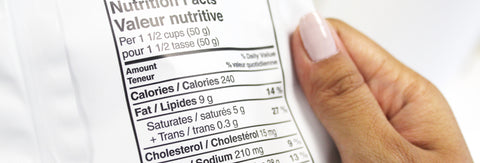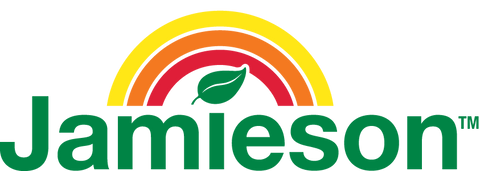Have you ever stood in the grocery aisle, staring at the back of two different food packages, trying to figure out which is the healthier choice? If you have, you’re not alone. Many Canadians compare food labels, but this is not always easy or straightforward.
To help us make informed nutrition choices, a food label in Canada includes both a nutrition facts table as well as a list of ingredients. However, the way the label is written and what is required on it, has changed. In 2017, after receiving feedback from average Canadians as well as stakeholders in the food industry, the Canadian government decided to make improvements to the information required on food labels. The food industry was given a 5-year transition period, meaning that although some companies may already have updated their labels, others have until 2022 to become compliant. This changeover period has made comparing labels between different brands even more difficult.
Many people check nutrition labels to see how much sugar it contains. This is important for those who are diabetic, as well as those looking to maintain a healthy weight. When thinking of “sugar” you likely picture the white table sugar used for baking or adding to coffee and tea. However, there are many different types of sugars, including not only sucrose (table sugar) but also fructose (fruit sugars), and lactose (milk sugars). These 3 sugars are the most recognized on a label, yet there are many more, like dextrose and maltose. Biochemists use the suffix “-ose” for naming sugars, so remember, when looking at a food label, any word ending in “ose” is a sugar.
One of the main changes to the new labels, is that all sugar-based ingredients must be grouped together in brackets after the word “sugars.” This includes not only all the sugars ending in “ose” but also other more “natural” sugars such as agave syrup, honey, maple syrup, barley malt extract or fancy molasses, as well as fruit juice concentrates and purée concentrates that are added to replace sugars in foods. This will allow you to identify all of the sources of sugars that have been added.
To ensure labels are easier to read, the ingredients on the new labels must now be written in black font on white or neutral background, and the size of the font has a minimum height requirement to ensure the writing is not too small to read. These font regulations are also required for the “contains” section of the label which must list all Health Canada priority allergens. This helps people with common food allergies, to easily identify whether it is a safe food for them.
One of most important label changes is in the serving size information. Some companies have used smaller serving sizes to make their food look healthier. For instance, potato chip bags have had labels with a small font saying “per 5 chips”. How many people do you know who open a bag and only eat 5 chips? Instead, the new nutrition table requires a larger font size for the calories and serving size as well as adding a bold line under the calories to make it stand out more. The new serving sizes are now based on regulated reference amounts, to provide a more realistic portion size that someone might eat in one sitting.
When looking at the nutrition table beyond the calories, sugar and serving size, the other thing to pay attention to are the DVs. DV stand for daily value and are found on the right side of a nutrition facts table. They are meant to provide you with insight into whether a serving has a little or a lot of a nutrient. Generally, 5% DV or less is considered a little, while anything 15% or more is considered a lot. These DVs are based on either Health Canada’s recommended daily intakes (RDA) of vitamins and minerals or on other reference standards used for carbohydrates, fibre, fats, cholesterol, and sodium. Many of the nutrient amounts are shown using a DV%. This allows you to know how much of the daily required nutrient is in the serving size.
Although it is great to be given these calculations, they are not providing you with all the information you may need. The daily values are based on the average among genders and all ages. For instance, the daily value of iron used on food labels is 14 mg, however, Health Canada’s RDA for iron varies between 7 – 27 mg depending on gender, age and if you are pregnant or lactating. That is a big difference!
It’s also important to note that the original nutrition table required information on 13 core items: calories, fat, saturated fat, trans fat, cholesterol, sodium, carbohydrates, fibre, sugars, protein, calcium and iron. This means even if the food does not contain one of those particular items, it must still be listed on the chart with the amount of 0. The new label will no longer require vitamin A or vitamin C but will instead require potassium. Potassium affects blood pressure and many Canadians are low in potassium. Always look for a nutrition chart with a higher potassium DV%, particularly in relation to a lower sodium DV%, as these 2 nutrients need to be balanced for healthy blood pressure. Some companies may choose to add in additional information on the following vitamins and minerals, if they feel it will improve sales: folate, magnesium, niacin (vitamin B3), phosphorus, riboflavin (B2), selenium, thiamine (vitamin B1), vitamin B6, vitamin B12, vitamin D, vitamin E and zinc.
With each nutrient requirement, there are many variables to be considered. What is listed on a food label is the most basic recommendation. Food labels are obviously not able to take into consideration an individual person’s size or the differences between someone with a sedentary lifestyle versus an active lifestyle. This is why as a nutritionist, I always recommend a multi-vitamin that is specifically formulated with age and gender in mind. It is also important to look for formulas for specific times of life such as pregnancy as well as higher potency formulas for those with an active lifestyle. Multi-vitamins are like an insurance policy, to help to fill in possible nutrient gaps from your diet. By taking a specifically formulated daily multi-vitamin, you are at least receiving Health Canada’s RDAs for your age and gender groups, as well as if you are pregnant or lactating.
Not all foods have to be labeled, including fresh fruit, vegetables, and raw seafood as well as raw meat and poultry (except when it is ground). Although most health care practitioners would agree that creating meals from those foods are generally a more nutritious choice than packaged foods, it can be hard to know if you are making a fully nutritionally balanced meal. If you are struggling to understand your food choices, talk with a nutritionist who can help you to find the best individual healthy food plan for you.
References:
- Health Canada. Food Labelling Changes. Accessed June 24, 2019 at: https://www.canada.ca/en/health-canada/services/food-labelling-changes.html
- Health Canada. Understanding Food Labels, Percent Daily Values. Accessed June 24, 2019 at: https://www.canada.ca/en/health-canada/services/understanding-food-labels/percent-daily-value.html
- Health Canada. Dietary Reference Intakes. Accessed June 25, 2019 at: https://www.canada.ca/content/dam/hc-sc/migration/hc-sc/fn-an/alt_formats/hpfb-dgpsa/pdf/nutrition/dri_tables-eng.pdf




